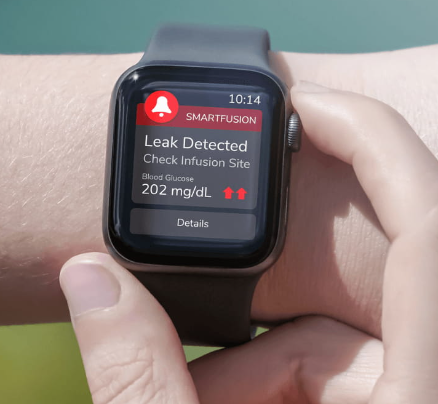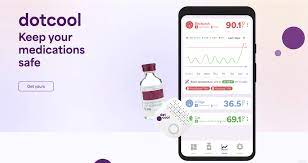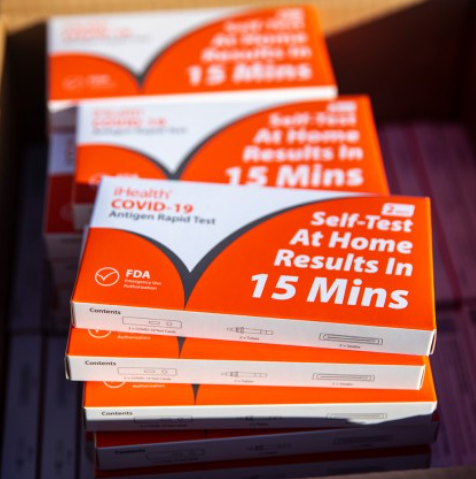New Vaccine Can Completely Reverse Autoimmune Diseases Like Multiple Sclerosis, Type 1 Diabetes, and Crohn’s Disease by the University of Chicago for SciTechDaily.com, 23 September 2023.
 Researchers at the University of Chicago’s Pritzker School of Molecular Engineering have developed a novel vaccine that, in laboratory tests, can completely reverse autoimmune diseases like multiple sclerosis, type 1 diabetes, and Crohn’s disease — all without shutting down the rest of the immune system.
Researchers at the University of Chicago’s Pritzker School of Molecular Engineering have developed a novel vaccine that, in laboratory tests, can completely reverse autoimmune diseases like multiple sclerosis, type 1 diabetes, and Crohn’s disease — all without shutting down the rest of the immune system.
A typical vaccine teaches the human immune system to recognize a The inverse vaccine, described in a recent paper published in Nature Biomedical Engineering, takes advantage of how the liver naturally marks molecules from broken-down cells with “do not attack” flags to prevent autoimmune reactions to cells that die by natural processes. PME researchers coupled an antigen — a molecule being attacked by the immune system— with a molecule resembling a fragment of an aged cell that the liver would recognize as friend, rather than foe. The team showed how the vaccine could successfully stop the autoimmune reaction associated with a multiple-sclerosis-like disease.
The job of the immune system’s T cells is to recognize unwanted cells and molecules — from viruses and bacteria to cancers — as foreign to the body and get rid of them. Once T cells launch an initial attack against an antigen, they retain a memory of the invader to eliminate it more quickly in the future. BUT, T cells can make mistakes and recognize healthy cells as foreign.
Jeffrey Hubbell, the Eugene Bell Professor in Tissue Engineering and lead author of the new paper, and his colleagues knew that the body has a mechanism for ensuring that immune reactions don’t occur in response to every damaged cell in the body— a phenomenon known as peripheral immune tolerance and carried out in the liver.
“The idea is that we can attach any molecule we want to pGal and it will teach the immune system to tolerate it,” explained Hubbell. “Rather than rev up immunity as with a vaccine, we can tamp it down in a very specific way with an inverse vaccine.”
Cell therapy developer closes funding round to support diabetes program by Kristin Jensen for BioPharmaDive.com, 21 September 2023. Attempting to transform diabetes treatment, Seraxis has raised more than $50 million from a series of investors that includes Eli Lilly.
 Seraxis wants to transform the lives of millions of diabetics who must take insulin every day to control their blood sugar levels by using a stem cell line, generated from human pancreas, to produce groups of cells known as organoids that can replicate the work of an organ. Specifically, Seraxis focuses on the production of insulin to control glucose levels. The biotech says its cells are as potent as ones normally found in a healthy pancreas and have been able to reverse diabetes in rats and mice.
Seraxis wants to transform the lives of millions of diabetics who must take insulin every day to control their blood sugar levels by using a stem cell line, generated from human pancreas, to produce groups of cells known as organoids that can replicate the work of an organ. Specifically, Seraxis focuses on the production of insulin to control glucose levels. The biotech says its cells are as potent as ones normally found in a healthy pancreas and have been able to reverse diabetes in rats and mice.
Seraxis plans to implant its cell therapy, dubbed SR-02, in humans who will be taking drugs to keep their bodies from rejecting a foreign substance, similar to the treatment a patient would get after receiving a full organ transplant. A “proof-of-concept” trial is expected to begin next year. The next step would be packaging the therapy in a device called SeraGraft to allow use in patients without the need for immunosuppressive medicines. Seraxis calls this combination SR-01.
Read more: Cell therapy developer closes funding round to support diabetes program
Medtronic simplifies diabetes lineup with European approval for long-awaited Simplera CGM sensor by Andrea Park for FierceBioTEch.com, 21 September 2023.
 Medtronic’s slimmed-down Simplera CGM has earned CE mark clearance, setting it up for a launch in Europe in the near future. The sensor is half the size of Medtronic’s last CGM, the Guardian 4, while also being easier to apply than its predecessor—via a two-step insertion process, using the included applicator tool—and is completely disposable. Plus, unlike the Guardian 4 sensor, the Simplera device adheres to the back of a user’s arm without requiring any additional tape or adhesive to keep it in place.
Medtronic’s slimmed-down Simplera CGM has earned CE mark clearance, setting it up for a launch in Europe in the near future. The sensor is half the size of Medtronic’s last CGM, the Guardian 4, while also being easier to apply than its predecessor—via a two-step insertion process, using the included applicator tool—and is completely disposable. Plus, unlike the Guardian 4 sensor, the Simplera device adheres to the back of a user’s arm without requiring any additional tape or adhesive to keep it in place.
The flatter, simplified sensor more closely resembles Dexcom and Abbott’s offerings, though Simplera’s seven-day wear period is the shortest of the three compared to the Dexcom G7’s 10-day span and Abbott FreeStyle Libre 3’s 14-day period.
The CE mark approval allows the Simplera sensor to be used alongside Medtronic’s InPen, a reusable insulin pen that uses Bluetooth to transmit dosage data to a mobile app. In addition to showing the dose history, as well as blood sugar readings from a connected CGM, the app features a dose calculator that analyzes those glucose readings to suggest optimal meal and correction doses of insulin.
Read more: Medtronic simplifies diabetes lineup with EU approval for Simplera CGM sensor
Diatech Diabetes Upgrades Diabetes Care Through AI-Powered Infusion Monitoring by StartUp Health for HealthTransformer.co, 14 September 2023.
 Insulin pump infusion failure occurs when the insulin pump tries to infuse into the connected site, but the tissue is either too inflamed for the medication to successfully be delivered, the insulin leaks from the injection site, the cannula on the infusion set is bent, or there is an occlusion of the flow path causing insulin to build up in the line. These issues can cause disturbances to the flow of insulin and may prevent an accurate medication dose, resulting in an under or over delivery of insulin that can cause severely imbalanced glucose levels. The scary truth is that it is very common, with over 250K incidents reported yearly. The trickiest part is that sometimes these infusion failures can be so sneaky that they go undetected, making efficient diabetes management quite a roller coaster ride without the fun.
Insulin pump infusion failure occurs when the insulin pump tries to infuse into the connected site, but the tissue is either too inflamed for the medication to successfully be delivered, the insulin leaks from the injection site, the cannula on the infusion set is bent, or there is an occlusion of the flow path causing insulin to build up in the line. These issues can cause disturbances to the flow of insulin and may prevent an accurate medication dose, resulting in an under or over delivery of insulin that can cause severely imbalanced glucose levels. The scary truth is that it is very common, with over 250K incidents reported yearly. The trickiest part is that sometimes these infusion failures can be so sneaky that they go undetected, making efficient diabetes management quite a roller coaster ride without the fun.
John Wilcox and Luis Ernesto Blanco met at Florida State University’s senior thesis research lab. John, who was diagnosed with Type 1 diabetes at the age of nine, had always seen the disease as an opportunity to make a difference rather than as a disability. So, for his senior thesis, he chose to address a problem he was quite familiar with — insulin pump therapy and leak detection. During their research, John and Luis recognized a handful of critical issues in the industry:
-
-
-
- Manufacturers weren’t incorporating better infusion failure sensors into CGMs and insulin pumps. Instead, they focused on hardware adjustments, like changing the infusion set adhesive and altering the cannula design to prevent infusion failure. Reducing infusion failure is important, but the risk of infusion failure still remains.
- Dermatological nature of infusion failures and the lack of standardization in the infusion set technology. Infusion failures could happen anytime due to compromised attachment, improper insertion, or accidental bumping into a hard surface. The existing insulin pumps have occlusion systems that detect blockages, but not issues like dislodgements or leakages. In addition, the detection time varied widely, from a few seconds to a few days, making potential failures life-threatening.
- The industry’s shift towards automated insulin delivery (AID) — combining continuous glucose monitors with insulin pumps to regulate insulin delivery automatically. They realized the heightened need to make infusions monitored and safer by leveraging software solutions, which led to the development of SMARTFUSION.
-
-
Over the years, Diatech Diabetes has achieved significant milestones, including a Phase One SBIR grant from the NIH in 2021 and establishing R&D partnerships with two insulin pump companies for full software integration. SMARTFUSION™ is a software-based platform that monitors insulin infusion in real-time, providing critical benefits for people with diabetes and insulin pump manufacturers. It ensures proper insulin delivery and alerts users to replace the pump’s disposable part when needed to prevent potential hyperglycemia and even fatal outcomes.
Read more: Diatech Diabetes Upgrades Diabetes Care Through AI-Powered Infusion Monitoring
Storing Insulin in the Dorm Fridge: A Student’s Guide by Amin Zayani, founder of DotCool, 19 September 2023.
 Living in a dorm can be an exhilarating experience, offering a unique blend of freedom, academic rigor, and social interactions. But, if you’re a student living with diabetes, it also presents a few challenges – especially when it comes to storing insulin. Dorm fridges aren’t always the most reliable or suitable for medication storage. However, with a few tweaks, you can ensure your insulin stays safe and effective.
Living in a dorm can be an exhilarating experience, offering a unique blend of freedom, academic rigor, and social interactions. But, if you’re a student living with diabetes, it also presents a few challenges – especially when it comes to storing insulin. Dorm fridges aren’t always the most reliable or suitable for medication storage. However, with a few tweaks, you can ensure your insulin stays safe and effective.
Causes of Problems in Dorm Fridges:
Technical causes: Not made for medication storage (Dorm fridges are primarily designed for storing snacks and drinks, not delicate medications like insulin.); Rough regulation (These fridges often lack the fine-tuned temperature controls needed to maintain consistent coolness.); Ice build-up (Over time, these fridges can accumulate ice, potentially freezing or affecting stored items.); Poor ventilation (Unlike medical refrigerators, which have an internal fan to circulate cold air, limited airflow in small dorm fridges can cause temperature inconsistencies, leading to hot and cold spots.); Power outages (There’s always the chance of a dorm fridge losing power, either from electrical issues or accidental unplugging.)
Use-induced causes: Freezer mix-ups (It’s not uncommon to mistakenly place insulin in the freezer section or to have it pushed there inadvertently.); Door left open (Roommates might leave the fridge door open, especially when distracted, tired, or after a few beers.); Six pack surge (Suddenly storing a large number of items, like a six-pack, can momentarily raise the internal temperature. Though not the biggest issue, it’s worth noting.); Pushed to the back (If not properly secured, insulin can be pushed to the back of the fridge where it might freeze.); Accidental unplugging (Whether cleaning, moving things around, or just being careless, someone might unplug the fridge, compromising your insulin’s efficacy.)
 Solutions: Use an airtight box (Placing your insulin in a sealed box can help maintain its temperature, even if there are fluctuations in the fridge’s internal environment.); Label it (Ensure that the insulin box is clearly labeled. The extra visibility helps from moving it around or taking it out. A simple “DO NOT MOVE – MEDICATION INSIDE” can work wonders.); Educate your roommate (Have a conversation and make sure they understand the importance of properly storing insulin. This includes not leaving the fridge door open, not unplugging it, and being cautious about where they place items.); Temperature monitoring (Invest in a product like dotcool mini or any reliable temperature monitor. This allows you to keep an eye on the insulin’s environment, ensuring it remains at an optimal temperature.)
Solutions: Use an airtight box (Placing your insulin in a sealed box can help maintain its temperature, even if there are fluctuations in the fridge’s internal environment.); Label it (Ensure that the insulin box is clearly labeled. The extra visibility helps from moving it around or taking it out. A simple “DO NOT MOVE – MEDICATION INSIDE” can work wonders.); Educate your roommate (Have a conversation and make sure they understand the importance of properly storing insulin. This includes not leaving the fridge door open, not unplugging it, and being cautious about where they place items.); Temperature monitoring (Invest in a product like dotcool mini or any reliable temperature monitor. This allows you to keep an eye on the insulin’s environment, ensuring it remains at an optimal temperature.)
Read more: Storing Insulin in the Dorm Fridge: A Student’s Guide
Spinach extract may help diabetic wounds heal faster by Robby Berman for MedicalNewsToday.com, 21 September 2023.
 A new study in rats suggests that extracts of spinach, Spinacia oleracea, could help promote the healing of diabetic ulcers. Chronic diabetic ulcers are a serious problem for people with diabetes and can persist for months or even years. About 15% of people with diabetes have lower-extremity ulcers that will not heal, often resulting in amputation. Chronic diabetic ulcers affect roughly 6.3% of the world’s overall population. A new study, published in Scientific Reports, found that spinach extract can improve the healing of diabetic wounds and promote weight loss, a benefit for people with diabetes who are often overweight.
A new study in rats suggests that extracts of spinach, Spinacia oleracea, could help promote the healing of diabetic ulcers. Chronic diabetic ulcers are a serious problem for people with diabetes and can persist for months or even years. About 15% of people with diabetes have lower-extremity ulcers that will not heal, often resulting in amputation. Chronic diabetic ulcers affect roughly 6.3% of the world’s overall population. A new study, published in Scientific Reports, found that spinach extract can improve the healing of diabetic wounds and promote weight loss, a benefit for people with diabetes who are often overweight.
Registered dietitian nutritionist Yelena Wheeler, not involved in the study, explained, “Red blood cells are the foundation of new tissue as it creates collagen. Collagen forms new skin tissue, which grows over the wound, causing it to heal and decrease in size.”
When a wound occurs, white blood cells, proteins, nutrients, and oxygen-bound red blood cells are sent for clotting and healing, registered dietitian nutritionist Cesar Sauza, also not involved in the study, added. “All of these compounds have their role in wound-healing,” he said.
For people with diabetes, however, “high blood sugar levels can lead to stiffened blood vessels, slowing down circulation and reducing oxygen supply to the tissues,” explained integrative registered dietitian nutritionist Kelsey Costa, not involved in the research. “This also impairs the function of white blood cells, leaving a wound more likely to become infected,” she said. “Additionally, peripheral neuropathy can cause a reduced sense of pain, meaning wounds may go unnoticed and untreated, becoming chronic, especially in lower limbs like the foot, which are more susceptible to minor injuries.”
Read more: Spinach extract may help diabetic wounds heal faster
Novo Nordisk taps Ypsomed for long-term supply of autoinjectors by Dulan Lokuwithana for SeekingAlpha.com, 20 September 2023.
 Swiss medical device maker Ypsomed Holding announced a long-term supply agreement with Novo Nordisk to provide the Danish drugmaker with a sizable amount of autoinjectors. The company added that the autoinjectors will be designed for self-administration of therapeutics for multiple metabolic conditions.
Swiss medical device maker Ypsomed Holding announced a long-term supply agreement with Novo Nordisk to provide the Danish drugmaker with a sizable amount of autoinjectors. The company added that the autoinjectors will be designed for self-administration of therapeutics for multiple metabolic conditions.
Plans are also underway to expand its production capacity in the years ahead, backed by significant investments from Novo. Under a royalty scheme, rights for production will be made available for third-party manufacturers to ease supply constraints. Ypsomed’s head of investor relations, Thomas Kutt, told Reuters that the devices will be used to deliver Novo’s “second-generation GLP-1s.” Novo is struggling to meet the demand for its newer weight-loss therapy, semaglutide.
Read more: Novo Nordisk taps Ypsomed for long-term supply of autoinjectors
What you need to know to — once again — get free at-home COVID tests by Harriet Rowan for OCRegister.com, 21 September 2023.
 The Biden administration announced that it would once again begin mailing rapid at-home COVID tests to American households, free of charge. The news comes amid one of the largest COVID surges the country has seen, with hospitalizations and deaths both rising, though far from record highs.
The Biden administration announced that it would once again begin mailing rapid at-home COVID tests to American households, free of charge. The news comes amid one of the largest COVID surges the country has seen, with hospitalizations and deaths both rising, though far from record highs.
Every U.S. household can request a new shipment of free tests, starting Monday, Sept. 25. The tests will be available through the U.S. Department of Health and Human Services’ COVID website — covid.gov/tests — and will be delivered by the U.S. Postal Service. Each household is eligible for 4 free tests delivered directly to the home, regardless of how many tests your household received in previous rounds.
If you have old rapid at-home tests in the medicine cabinet, public health officials are encouraging people to check to see if the expiration date has been retroactively extended on this list from the Food and Drug Administration. You can find the list on the FDA website, fda.gov.
Read more: What you need to know to — once again — get free at-home COVID tests


I really hope that the new Medtronic CGM is successful. They have been good for me since Guardian phase 1. But I know others will not even try it.
I know it will require an associated company to punch through.
Yeah new test kit on its way. Yipppee !!